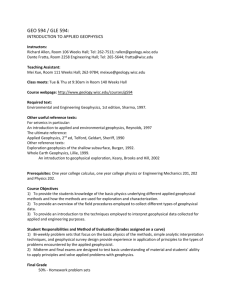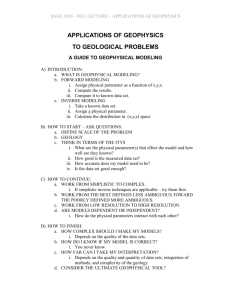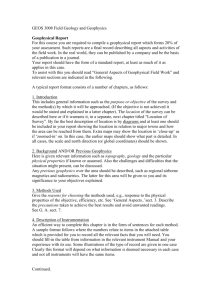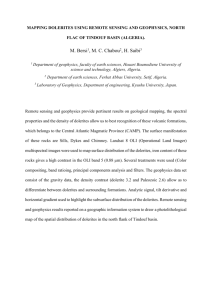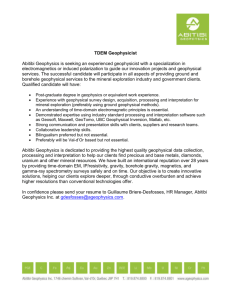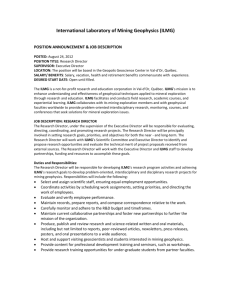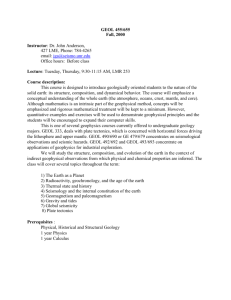200907-july-ns-newsletter
advertisement
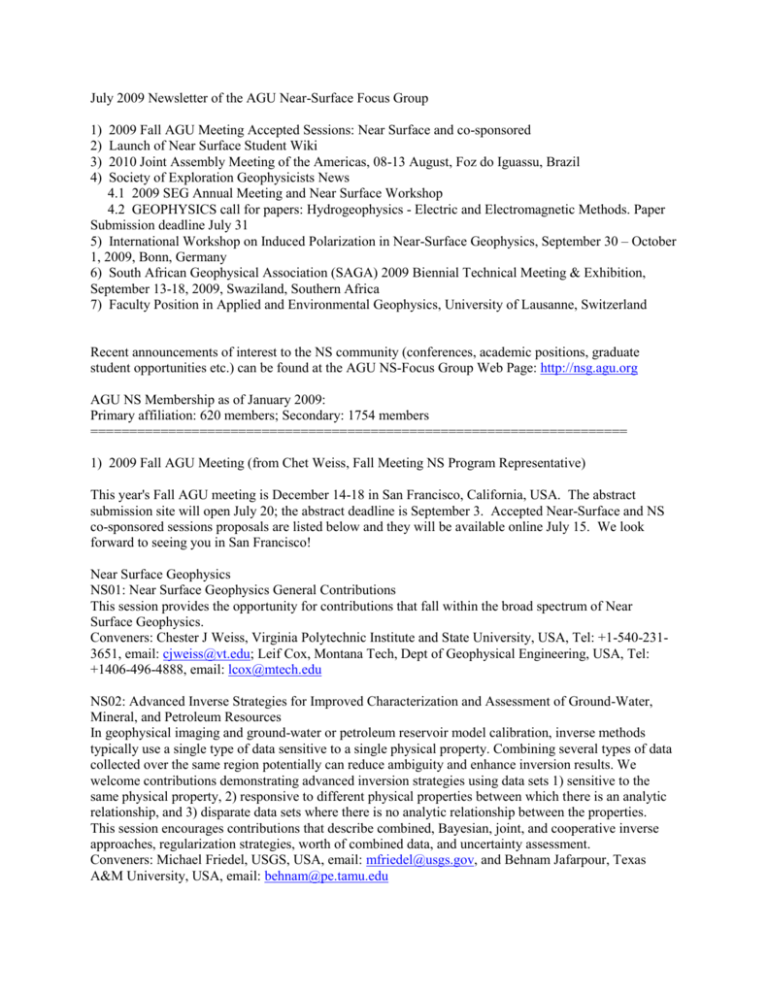
July 2009 Newsletter of the AGU Near-Surface Focus Group 1) 2) 3) 4) 2009 Fall AGU Meeting Accepted Sessions: Near Surface and co-sponsored Launch of Near Surface Student Wiki 2010 Joint Assembly Meeting of the Americas, 08-13 August, Foz do Iguassu, Brazil Society of Exploration Geophysicists News 4.1 2009 SEG Annual Meeting and Near Surface Workshop 4.2 GEOPHYSICS call for papers: Hydrogeophysics - Electric and Electromagnetic Methods. Paper Submission deadline July 31 5) International Workshop on Induced Polarization in Near-Surface Geophysics, September 30 – October 1, 2009, Bonn, Germany 6) South African Geophysical Association (SAGA) 2009 Biennial Technical Meeting & Exhibition, September 13-18, 2009, Swaziland, Southern Africa 7) Faculty Position in Applied and Environmental Geophysics, University of Lausanne, Switzerland Recent announcements of interest to the NS community (conferences, academic positions, graduate student opportunities etc.) can be found at the AGU NS-Focus Group Web Page: http://nsg.agu.org AGU NS Membership as of January 2009: Primary affiliation: 620 members; Secondary: 1754 members ===================================================================== 1) 2009 Fall AGU Meeting (from Chet Weiss, Fall Meeting NS Program Representative) This year's Fall AGU meeting is December 14-18 in San Francisco, California, USA. The abstract submission site will open July 20; the abstract deadline is September 3. Accepted Near-Surface and NS co-sponsored sessions proposals are listed below and they will be available online July 15. We look forward to seeing you in San Francisco! Near Surface Geophysics NS01: Near Surface Geophysics General Contributions This session provides the opportunity for contributions that fall within the broad spectrum of Near Surface Geophysics. Conveners: Chester J Weiss, Virginia Polytechnic Institute and State University, USA, Tel: +1-540-2313651, email: cjweiss@vt.edu; Leif Cox, Montana Tech, Dept of Geophysical Engineering, USA, Tel: +1406-496-4888, email: lcox@mtech.edu NS02: Advanced Inverse Strategies for Improved Characterization and Assessment of Ground-Water, Mineral, and Petroleum Resources In geophysical imaging and ground-water or petroleum reservoir model calibration, inverse methods typically use a single type of data sensitive to a single physical property. Combining several types of data collected over the same region potentially can reduce ambiguity and enhance inversion results. We welcome contributions demonstrating advanced inversion strategies using data sets 1) sensitive to the same physical property, 2) responsive to different physical properties between which there is an analytic relationship, and 3) disparate data sets where there is no analytic relationship between the properties. This session encourages contributions that describe combined, Bayesian, joint, and cooperative inverse approaches, regularization strategies, worth of combined data, and uncertainty assessment. Conveners: Michael Friedel, USGS, USA, email: mfriedel@usgs.gov, and Behnam Jafarpour, Texas A&M University, USA, email: behnam@pe.tamu.edu NS03: Back to Basics: Inversion of Electrical Resistivity Imaging Data Electrical resistivity imaging (ERI) can be used to obtain information about subsurface structure, properties, and processes for a wide range of near-surface applications. A critical step in the use of ERI is the inversion of the acquired data to obtain an image that displays the magnitude of the electrical resistivity throughout the subsurface region of interest. In obtaining this image, the geophysicist is immediately faced with several critical choices – such as, which inversion algorithm, its implementation and the incorporation of prior geologic knowledge and constraints – which can significantly affect the obtained resistivity image in ways that are not often documented or well understood. This “Back to Basics” session will be a community discussion about the inversion of ERI data. Synthetic and field data sets will be posted at the AGU Near-Surface Focus Group website (nsg.agu.org), along with information about the acquisition parameters and some limited information about the geology at the site. We ask that volunteers (e.g. you, reading this session description) download one or more of these data sets and invert them using any method to obtain the resistivity model/s. In this session we will compare and discuss the results, and review the “answers” for the synthetic data sets. All abstracts submitted to this session will therefore be from those who have completed the homework assignment. All submitted presentations will be made as posters. This Back to Basics session is an opportunity for our community to have an in-depth discussion about the inversion of ERI data – the advances, the challenges, the limitations, and the outstanding questions. Conveners: Chester Weiss, Virginia Tech, Dept of Geosciences 4044 Derring Hall (0420), Blacksburg, VA 24061 USA, email: cjweiss@vt.edu, and Rosemary Knight, Stanford University, USA, email: rknight@stanford.edu NS04: Back to Basics: Measurement of Electrical Properties of Rocks and Sediments The interpretation of electrical and EM geophysical data acquired for hydrogeological and exploration applications relies on an understanding of how bulk electrical properties such as conductivity, induced polarization, dielectric constant, and self-potentials are related to many pore-scale petrophysical properties and physical/ chemical/ biological processes. Laboratory experiments play a crucial role in revealing these relationships and yet the procedures required to make high quality lab measurements that are representative of in- situ conditions and free of experimental artifacts remain a source of lively debate. We welcome contributions on the topic of electrical properties measurement over the full span of frequencies (DC to hundreds of MHz) used in resistivity, IP, SP, EM and GPR methods. Conveners: Karl E Butler, University of New Brunswick, Department of Geology 2 Bailey Dr., Fredericton, NB E3B 5A3 CAN, Tel: 506-458-7210, Fax: 506-453-5055, email: kbutler@unb.ca, and James Merriam, University of Saskatchewan, Dept. of Geological Sciences 114 Science Place, Saskatoon, SK S7N 5E2 CAN, Tel: (306) 966-5716, Fax: (306) 966-8593, email: jim.merriam@usask.ca NS05: Urban Geophysics Unprecedented industrial growth and rapid urbanization are causing a host of problems and challenges to established and emerging human settlements all over the world. Systematic application of various geophysical methods, individually or in combination, can play a vital role in finding solutions to a number of these problems. The session invites contributions on conceptual developments and applications of various geophysical methods dealing with: urban planning and development, metro tunneling and transportation, seismic risk mitigation in populated areas, siting of heavy structures, archeological investigations and preservation of existing monuments, mining hazards and waste disposal, enhancement of potable water supply in problem areas, land slides in mountainous regions, power transmission, etc. Contributions of urban geophysical studies to special problems unlisted here, and those combining the results of airborne, ground, and bore hole surveys will be most welcome. Conveners: Saurabh Kumar Verma, National Geophysical Research Institute, Uppal Road, Hyderabad, AP 500007 IND, Tel: 91-40-23434601, Fax: 91-40-23434651, email: skvngri@gmail.com, and Shashi Prakash Sharma, Indian Institute of Technology, IIT Campus, Kharagpur, WB 721302 IND, Tel: 91 3222 - 283386, email: spsharma @ gg.iitkgp.ernet.in Near Surface Geophysics also presents jointly with the following Special Sessions: HH01: Emerging applications of hydrogeophysical methods for characterization and monitoring of reactive transport HH02: General Hydrogeophysics HH03: Characterization of Soil Moisture Dynamics and Plant-Soil Water Interactions HH04: Innovative field methods and new theoretical approaches of hydrogeophysics for hydraulic characterization of aquifers. HH05: Watershed hydrology, geophysics and remote sensing: from measurement to prediction HH06: Aquifer Characterization using Direct-Push Methods C28: Observatories, Tools and Instruments in Polar Regions HG09: Low-temperature geothermal energy HG14: Advances in the Quantitative Characterization of Karstic and Fractured Aquifers HG16: Challenges and Progress in Regional Groundwater Flow, Transport, and Reactive Transport Modeling HU08: Subsurface Flow Networks in the Landscape: Mapping, Monitoring, and Modeling IN11: Challenges in Achieving Earth System Model Interoperability T08: Fault processes in nature and lab: from micro scale to 3-D regional observations and models T26: Moho, Lithospere and Upper Mantle Structure Beneath Europe: What Have we Learnt in 100 Years? V36: Evidence for local stress changes preceding or accompanying volcanic activity V41: A Multidisciplinary Look at Volcanism in Continental and Oceanic Plate Interiors V48: Volcanic dynamics: temporal changes of physical properties at volcanoes with and without surficial activity --------------------------------------------------------------------2) Launch of Near Surface Student Wiki (ns-students.pbworks.com) (from Elliot Grunewald, NS student Representative) I am very excited to announce the launch of the Near Surface Student Wiki, a new resource designed to encourage dialogue between students in the Near Surface Focus Group. The best thing about the wiki format is that all pages and content can be created and edited directly by any student in the group. This means that the development of this resource and its future direction is up to each of us. For now, access to the wiki and "editor" privileges will only be available to registered NS students. Student members will receive an email with account information after distribution of the July newsletter. However, in the future, we may chose to widen access to other NS members as "readers" or to make the pages publicly viewable. As you will see when you first visit the wiki, what exists now is mostly a framework outlining a few early ideas of how the wiki can be best utilized. My hope is that content on the wiki will grow rapidly over the next month with your contributions. Please feel free to jump right in by creating or editing pages that will help serve the NS student community. --------------------------------------------------------------------3) 2010 Joint Assembly Meeting of the Americas, 08-13 August, Foz do Iguassu, Brazil (from Juan Lorenzo, JA 2010 NS Program Representative) The Near Surface Focus Group (NSFG) is a new and dynamic division of AGU that investigates the complex nature of near-surface geosystems. The Spring Joint Assembly (JA) has always been an exciting meeting for the NSFG. In 2010 the JA will be the Meeting of the Americas to be held in Foz do Iguassu, 08-13 August 2010, Brazil. Join us in this wonderful opportunity to tap the great diversity of experience of the American continents and develop professional collaborations with neighbors. It is also an excellent opportunity to travel to a beautiful, friendly part of the world and visit the Iguazu National Park and the Iguassu Falls. In late fall we will begin to accept proposals for sessions, but start thinking about it now. Contact a colleague to organize a session with a north-south counterpoint. Students are encouraged to collaborate and develop a session. Information about the meeting can be found at http://www.agu.org/meetings/ja10. If you have any questions or suggestions, please contact Juan Lorenzo (gllore@lsu.edu). --------------------------------------------------------------------4) Society of Exploration Geophysicists News 4.1 2009 SEG Annual Meeting and Near Surface Workshop (from Jan van der Kruk) The SEG 2009 meeting will take place from 25-30 October, 2009 in Houston, TX. The technical program contains several NSG sessions about Seismics, Inversion, Environmental & Engineering applications and Hydrogeophysics. On Friday, Rick Miller, John Bradford, Klaus Hollinger, Greg Baker, and Alan Levander are organizing a Post-Convention workshop on "Near Surface Seismology and GPR". This workshop is supported by the Near Surface Geophysics Section in cooperation with EEGS, EAGE Near Surface, and AGU Near Surface Focus Group. We hope to see many of you there. Additionally, there will be two NSGS events at this year's technical meeting that we also hope to see you at: An evening social event/business meeting for awards held at a restaurant very close to the convention center on Tuesday Oct 27th. The annual section's Business Meeting will be held at the convention center on an afternoon with minimal conflict to other NSG sessions. The NSGS thanks those members whom submitted or reviewed abstracts this year. Further information about the sessions and the Post-Convention workshop is provided on the NSGS website (http://nsgs.seg.org/). We are looking forward seeing you in Houston. 4.2 GEOPHYSICS call for papers SEG invites papers on the topic of "Hydrogeophysics – Electric and Electromagnetic Methods" for publication in the July-August 2010 special section or supplement of GEOPHYSICS. http://www.seg.org/SEGportalWEBproject/portals/SEG_Online.portal?_nfpb=true&_pageLabel=pg_gen_ content&Doc_Url=prod/SEG-Publications/Pub-Geophysics/Pub-Geo-Overview/SpecialSections/hydrogeo.htm Our principal aim is to review the theories of these techniques and their applications on various scales and within different geologic settings. With this special issue, we hope to foster a knowledge transfer and cross-fertilization among the different communities. Although we focus on electric and electromagnetic methods, including self-potential, induced polarization, nuclear magnetic resonance, the various EM methods, and ground-penetrating radar, we encourage related contributions, such as from electroseismic and seismoelectric methods. In addition, we are welcoming developments of new techniques for an improved characterization and monitoring of the shallow subsurface and groundwater-related processes, including those for biogeosystems. Interested authors should submit their manuscripts for review no later than 31 July 2009. In addition, the special section/supplement editors would like to receive a provisional title and list of authors as soon as possible. For specific questions, please contact the special section/supplement editors Jan van der Kruk (j.van.der.kruk@fz-juelich.de), André Revil (arevil@mines.edu), and Evert Slob (e.c.slob@tudelft.nl). --------------------------------------------------------------------- 5) International Workshop on Induced Polarization in Near-Surface Geophysics, September 30 – October 1, 2009, Bonn, Germany (http://ipworkshop.geo.uni-bonn.de/) In the induced polarization (IP) geophysical method the electrical polarizability of subsurface soils and rocks is measured for exploration purposes. While originally developed for the prospection and characterization of mineral deposits, which represent well polarizable targets, in recent years the value of the IP method also has been recognized for near‐surface studies in relatively low‐polarizable, sedimentary environments. The latter development has become possible due to considerable improvements over the last decade in instrumentation, macroscopic modeling and inversion techniques, and the understanding of the microscopic origin of IP. Promising applications of the IP method are particularly seen in the rapidly emerging fields of hydrogeophysics and biogeophysics, including for instance the characterization of hydraulic properties or the monitoring of biogeochemical processes in the subsurface. The aim of the workshop is to discuss the recent developments of the method as well as future research needs, applications and limitations. Any contribution on the subject is welcome, addressing for example data acquisition, petrophysical relationships, theory and laboratory studies, inverse modeling and imaging, or dealing with environmental, hydrological or engineering applications. Keynote Speakers: Andrew Binley, Lancaster University, UK; André Revil, Colorado School of Mines, USA; Lee Slater, Rutgers University, USA; Ken Williams, Lawrence Berkeley National Laboratory, USA The workshop will take place from September 30 to October 1, 2009 at the Universitätsclub Bonn e.V., Konviktstr. 9, 53113 Bonn, Germany. Deadline for registration is August 31, 2009. Workshop fees are € 60 for DGG members and/or students, and € 80 for others, including two lunch buffets during the workshop. Instructions for registration and pre‐payment of the workshop fees, and abstract submission are given on http://ipworkshop.geo.uni-bonn.de/. Deadline for submission of abstracts (max. half page) is August 31, 2009. Andreas Kemna, University of Bonn (Spokesman of the DGG IP working group) Adrián Flores‐Orozco, University of Bonn Geodynamics/Geophysics, Steinmann Institute, University of Bonn, Nussallee 8, 53115 Bonn, Germany, Phone: +49 228 73 9333, Fax: +49 228 73 2508 --------------------------------------------------------------------6) South African Geophysical Association (SAGA) 2009 Biennial Technical Meeting & Exhibition, September 13-18, 2009, Swaziland, Southern Africa (http://www.sagaonline.co.za/2009Conference/index.htm) This really is a near surface geophysics extravaganza and includes workshops and sessions from three hugely successful large international collaborative scientific research projects: Inkaba ye Africa, SAMTEX and AfricaArray. In addition there will be a plethora of sessions of exploration and innovative geophysics. Pre-conference geological field trip: 11-13 September to the Barberton Mountainland (Greenstone Belt), a proposed world heritage site. Visiting the Komati Valley and Sheba gold mine top (Eureka City), Golden Quarry and the Bon Accord Nickel deposit. Led by Professor Carl Anhaeusser (Wits University) --------------------------------------------------------------------7) Faculty Position in Applied and Environmental Geophysics, University of Lausanne, Switzerland The Faculty of Earth and Environmental Sciences at the University of Lausanne has an opening for a tenured position at the lecturer level in the field of applied and environmental geophysics. The new faculty member at the Institute of Geophysics will be expected to: (i) teach a variety of geophysics courses to undergraduate- and graduate-level students in earth and environmental sciences, (ii) develop an externally funded and internationally recognized research program, (iii) supervise undergraduate- and graduate-level students, and (iv) assume administrative duties at various levels within the University. Applications covering any domain of applied and environmental geophysics that will reinforce and/or complement current research activities are welcome. We are particularly interested in candidates with an academic track record of internationally recognized and independent research in one or more of the following domains: petrophysics, computational geophysics, or biogeophysics. An adequate command of French for teaching and administrative purposes is expected at the latest two years after the beginning of the appointment. This is an exceptional opportunity for a highly motivated and dynamic scientist with a dedication to excellence in both research and teaching to actively participate in the development of a rapidly evolving institute and faculty. Our institute is very well equipped and scenically located on the shores of Lake Geneva, a region of outstanding natural beauty offering a vibrant cosmopolitan atmosphere and an exceptionally high quality of life. To apply please send your CV, list of publications, reprints of the three to five most pertinent publications, and a summary of your research plans together with the names and addresses of three referees to Professor Lukas Baumgartner, Dean of the Faculty of Earth and Environmental Sciences, Amphipôle Building, University of Lausanne, CH-1015 Lausanne, Switzerland, doyen.gse@unil.ch. Deadline for the receipt of applications is September 15, 2009. The position is available from January 1, 2010, or at some later date to agree upon. For further information please visit http://www.unil.ch/gse or contact Prof. Lukas Baumgartner (doyen.gse@unil.ch) or Prof. Klaus Holliger (Klaus.Holliger@unil.ch). The University of Lausanne wishes to promote the access of women to academic careers and hence strongly encourages applications from qualified female candidates. ---------------------------------------------------------------------To contribute material to the NS-letter send an e-mail to: George Tsoflias tsoflias@ku.edu DEADLINE: Material must be received 2 full business days prior to the first of each month. GUIDELINES FOR SUBMISSIONS: All members are welcome to submit content of interest to the NS community. Please keep messages brief and provide contact information and (if available) a web address for additional information. AGU requests formatting of e-mail messages to be as simple as possible (no bold characters (use ALL CAPS instead), no color font, or other special formatting of text and paragraphs). E-mail attachments cannot be distributed.
